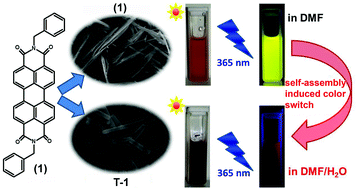Self-assembly, optical, thermal and electrochemical properties of bis-N-benzyl perylene diimide dye†
Abstract
Flexible methylene containing N,N′-bis-(benzyl)-3,4,9,10-perylenebis(dicarboximide) (1) was synthesized. Self-assembled microstructures (hollow tubes, average length and width: 7.7 and 0.8 μm) of 1 were also prepared (T-1). Comparative studies of the optical, thermal and electrochemical properties of 1 and T-1 have been extensively carried out. The T-1 hallow tubes have shown extremely broad absorption in the near-infrared (300–800 nm) region (NIR) even in solution and intensified conductivity in the solid-state compared to 1. Under daylight and a UV lamp (365 nm), the emission colors of 1 are uniform pink and fluorescent yellow, respectively. Under the same conditions the colors of T-1 change to deep brown and glowing red, respectively. Two different isopotential points obtained through CV scans for 1 indicate the presence of two interconvertible chromophores within the system. The results clearly indicate that the anodic and cathodic processes are extremely intensified in the self-assembled T-1 structure.



 Please wait while we load your content...
Please wait while we load your content...